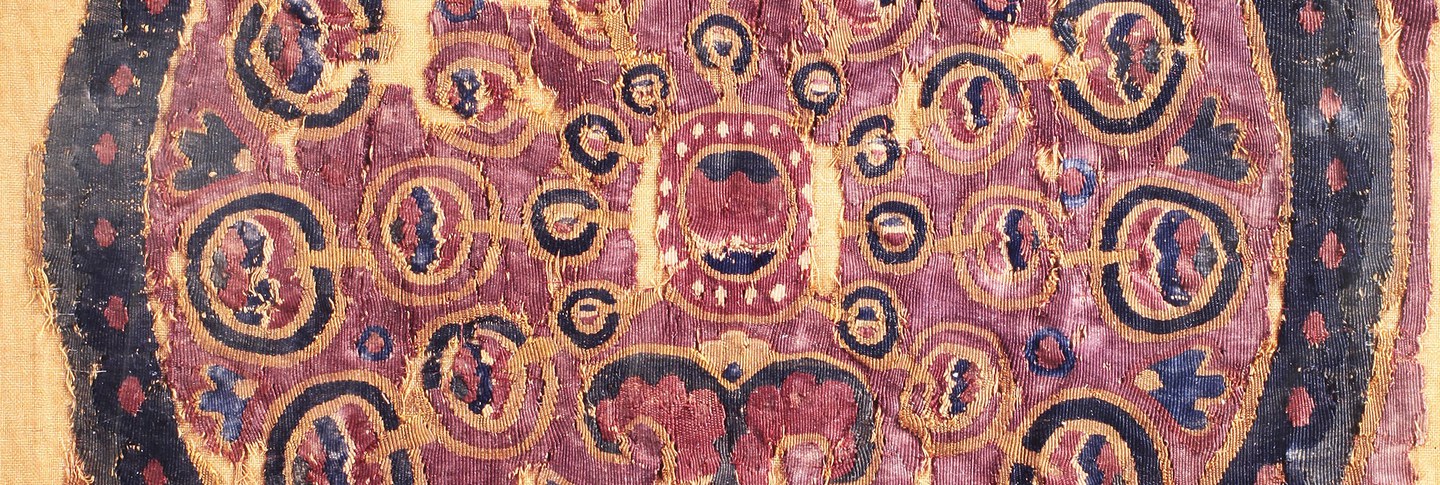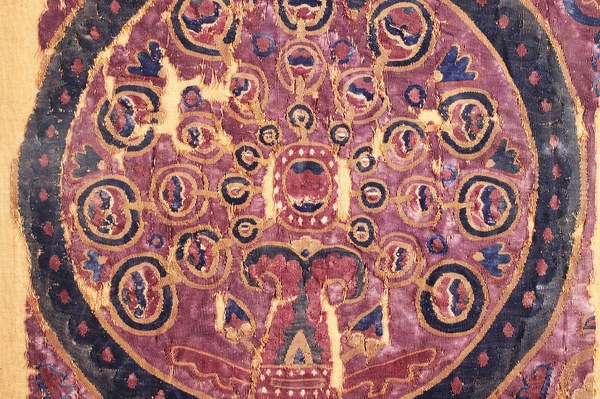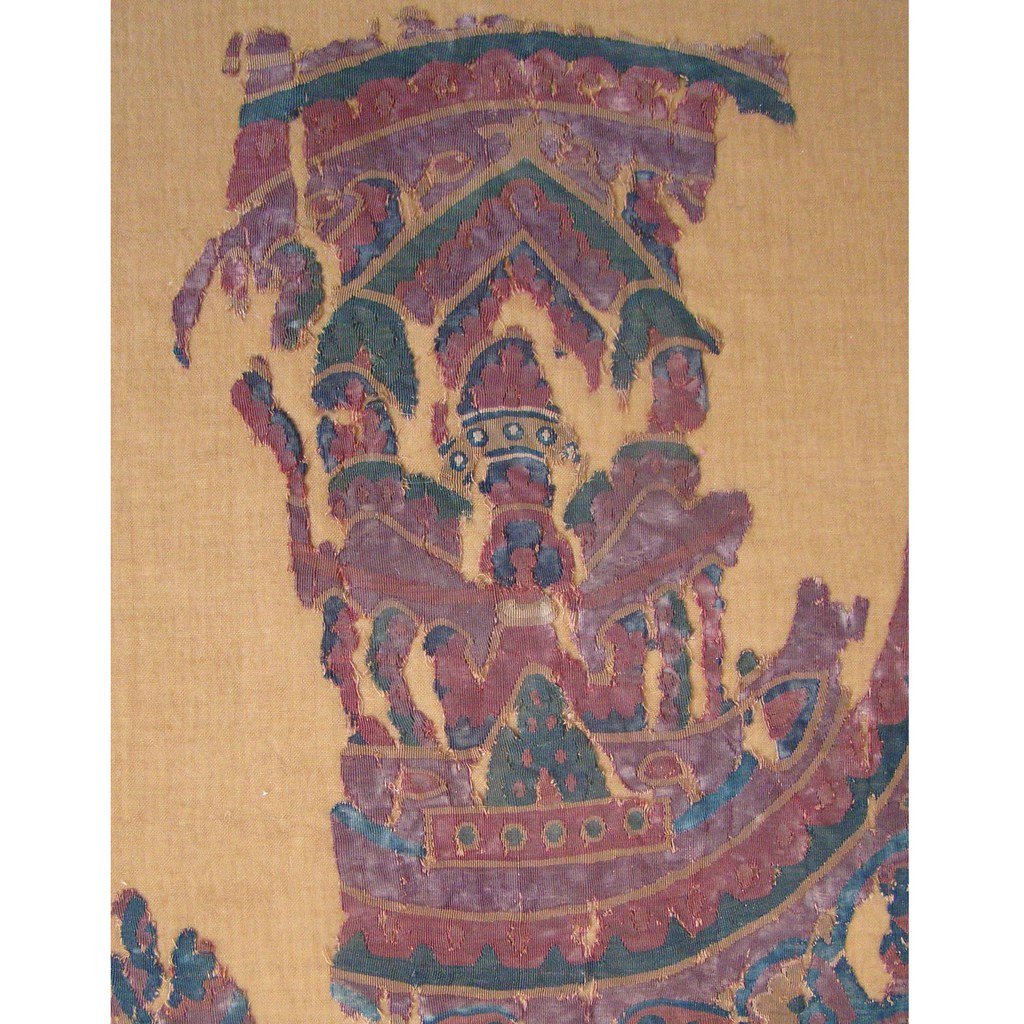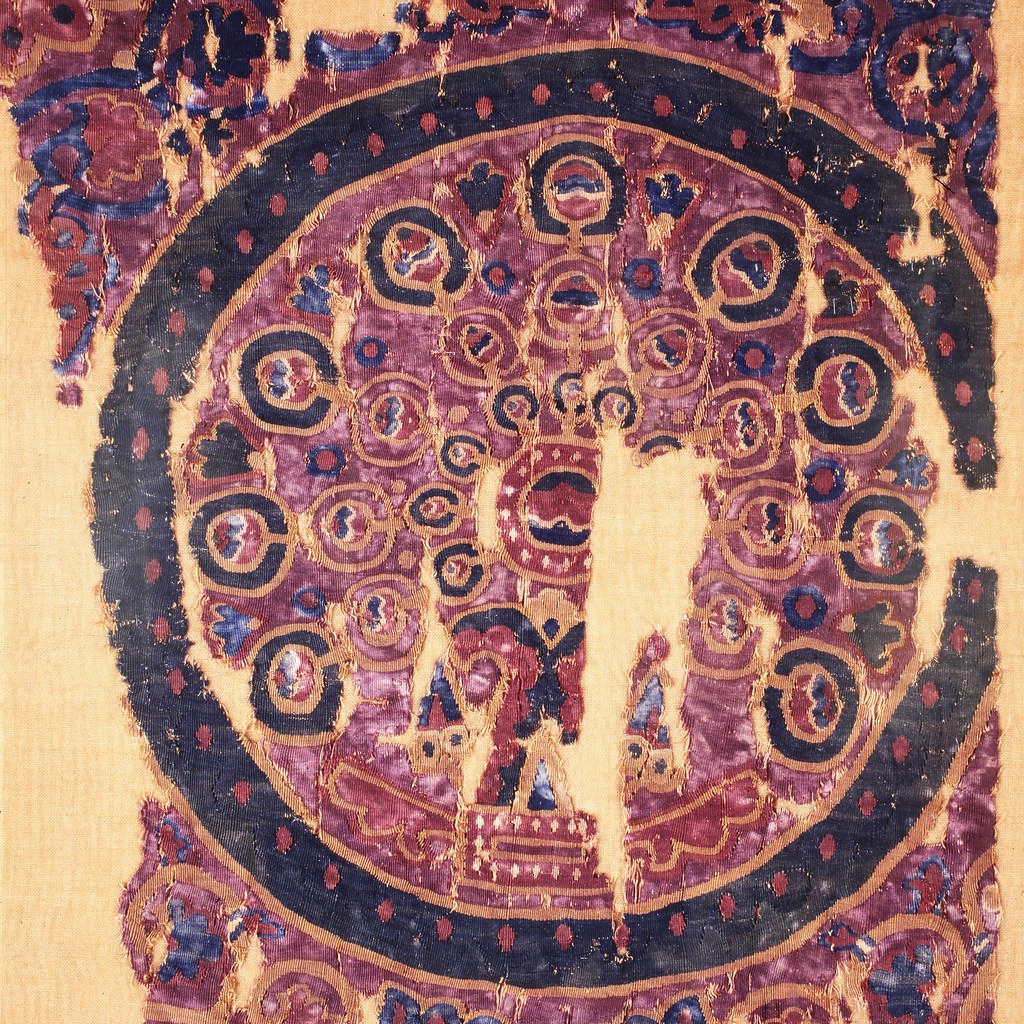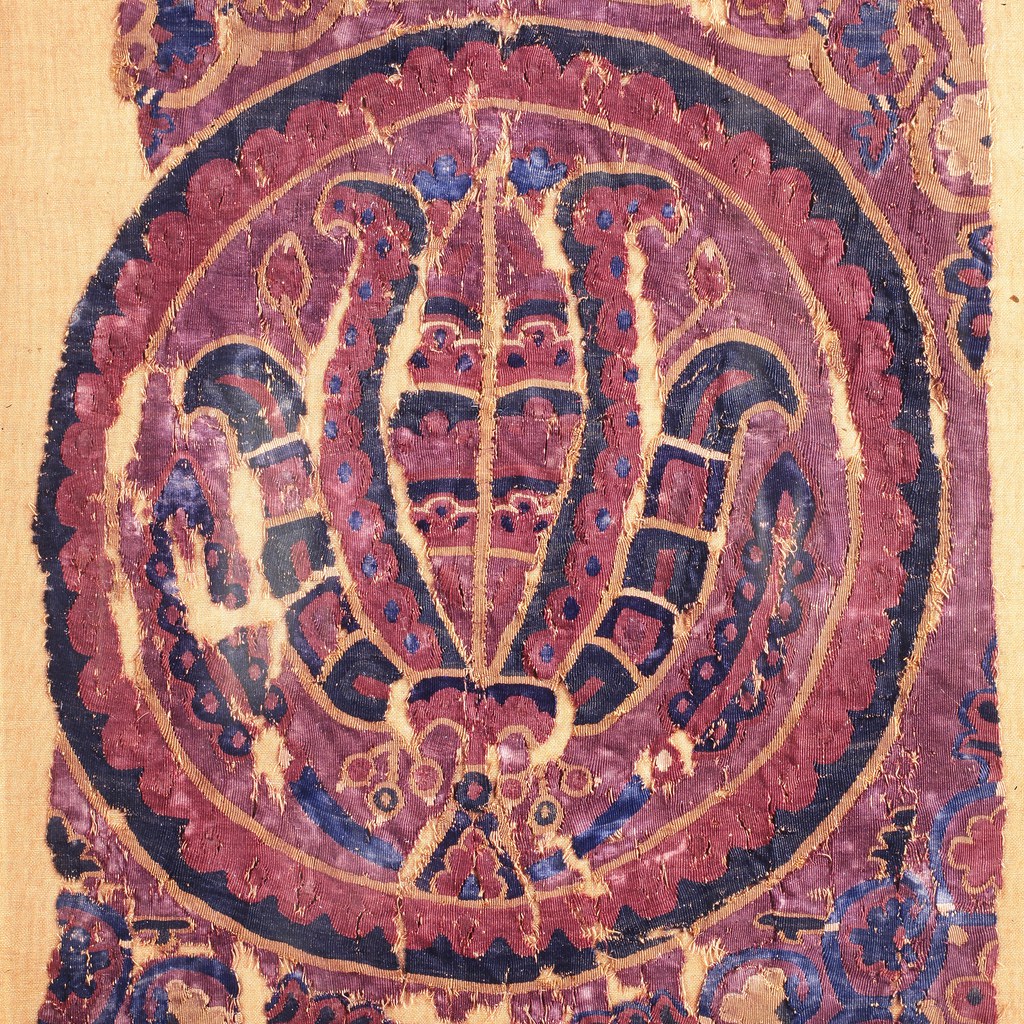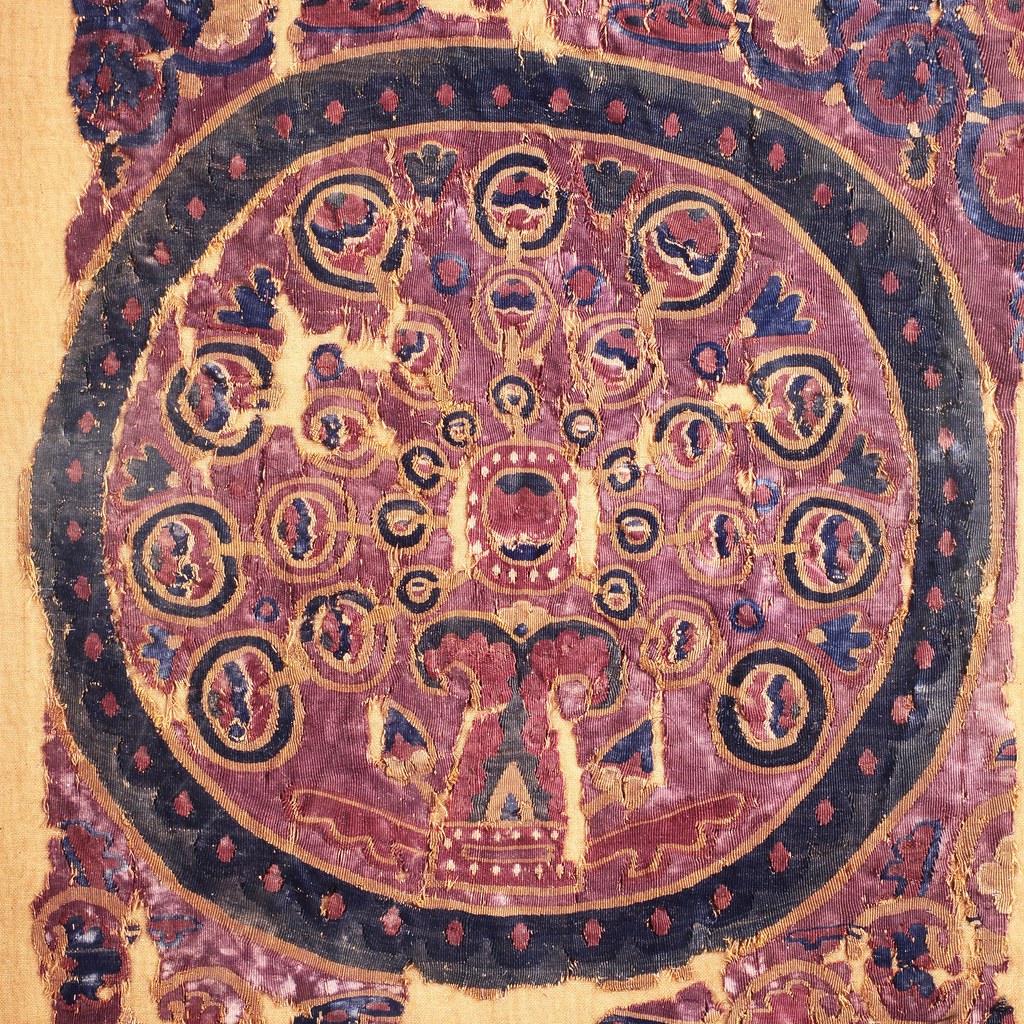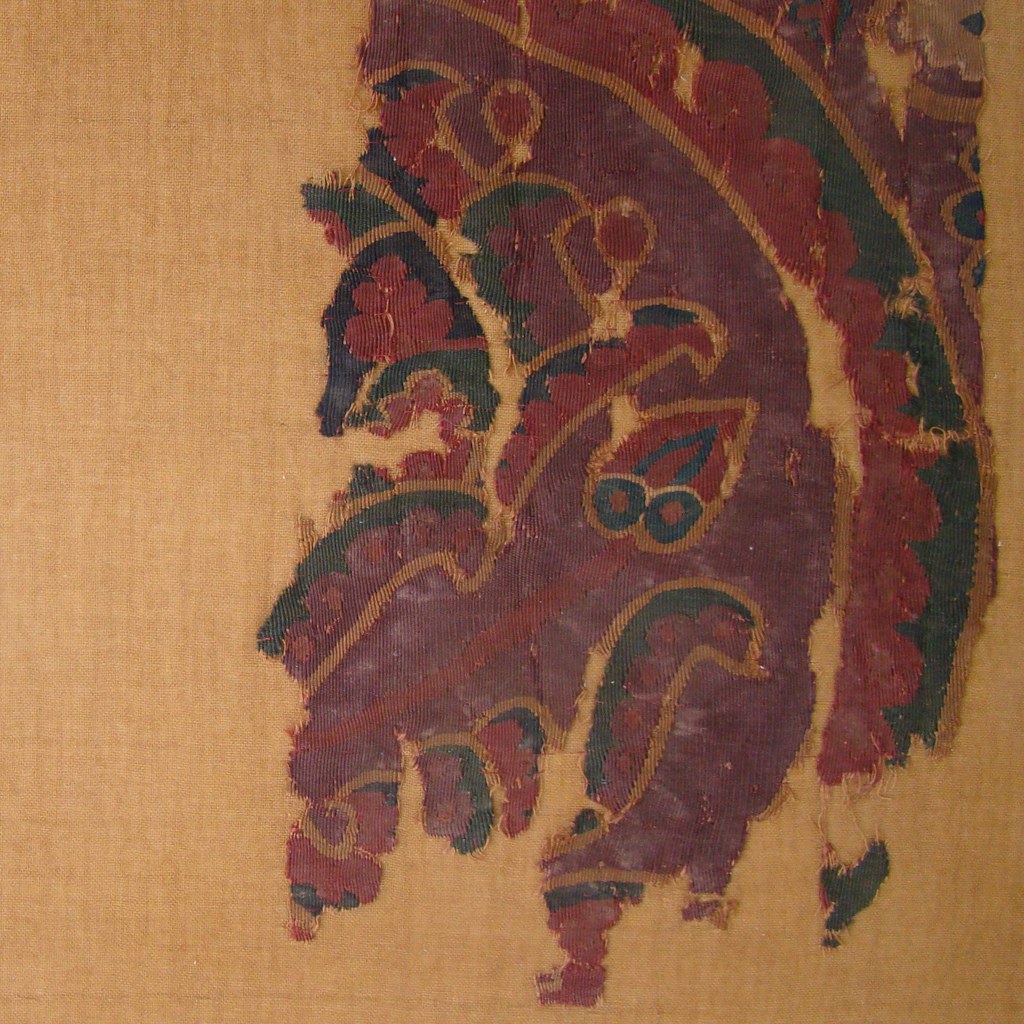For Joško Belamarić, who introduced me to this work of art
Although the study of medieval textiles has attracted the interest of numerous historians, anthropologists, and art and architectural historians since the second half of the nineteenth century, very few studies have focused on the artistic significance that textiles acquired in the religious, social, and political domains of medieval societies.See mainly J. Karabacek, Die persische Nadelmalerei, Susandschird: Ein Beitrag zur Entwicklungs-Geschichte der Tapisserie de Haute Lisse; Mit Zugrundelegung eines aufgefundenen Wandteppichs nach morgenländischen Quellen dargestellt (Leipzig, 1881); A. Riegl, Altorientalische Teppiche (Leipzig, 1891); O. von Falke, Kunstgeschichte der Seidenweberei (Berlin, 1913); and, in particular, Semper’s well-known discussion of textiles as related to the history of architecture: G. Semper, Die textile Kunst für sich betrachtet und in Beziehung zur Baukunst, vol. 1 of Der Stil in den technischen und tektonischen Künsten oder praktische Ästhetik: Ein Handbuch für Techniker, Künstler und Kunstfreunde (Frankfurt, 1860); for a discussion of Semper’s heritage, see A. Payne, From Ornament to Object: Genealogies of Architectural Modernism (New Haven, CT, 2012), 25–64. The citation that appears in the title of this article is a saying of the early Umayyad poet ʿAbd Allāh ibn Ruʾba al-ʿAjjāj (d. ca. 715). The English translation is taken from Muḥammad ibn Aḥmad al-Bīrūnī, The Book Most Comprehensive in Knowledge on Precious Stones, trans. H. M. Said (Delhi, 2004), 32. Whereas most historians have been interested in aspects concerning the production of raw material, fabrication, and distribution (i.e., trade), art historians have been mainly occupied with categorizing textiles according to specific techniques and, first and foremost, identifying their sites of production. Moreover, as innovations and peculiarities in textile-production techniques are typically bound to site-specific “workshops,” in many instances certain sites were immediately associated with one distinctive type of production. As a result, the “mapping” of the medieval production of textiles became rigid and fixed. The great importance given to the topography of textile techniques has dispossessed art historians of their major task of dating and locating works of art on stylistic bases and aesthetic concepts. Consequently, the field of textiles has come to be the domain of textile experts, namely those who have specialized in the careful analysis of the various techniques of weaving, embroidering, and even sewing or coloring. A society of experts thus governs the research, and their knowledge of the making of textiles has yielded a terminology for describing in detail the varied and complicated techniques of weaving, sewing, stitching, and cross-stitching that can cause the reader to feel exhausted and empowered in equal measure.
Several studies focusing on terminologies, mainly undertaken by philologists, have broadened our understanding but also reinforced and fortified typology as the major method of approaching textiles.For Islamic textiles, see mainly R. B. Serjeant, “Material for a History of Islamic Textiles up to the Mongol Conquest,” Ars Islamica 9 (1942): 54–92; 10 (1943): 71–104; 11–12 (1946): 98–145; 13 (1948): 75–117; 15–16 (1951): 29–85. Clothes, for instance, are mainly classified by medieval historians and art historians, by paying attention to different types of dresses, head covers, overcoats, and so on. These scholarly approaches admittedly are clearly embedded in the social and anthropological contexts of medieval society, because one is usually bound to discuss a particular garment or head cover as related to a specific ethnic group, social stratum, or gender.I refer here mainly to the study of textiles of the medieval Islamic and the Mediterranean worlds. See L. Golombek, “The Draped Universe of Islam,” in Content and Context of Visual Arts in the Islamic World: Papers from a Colloquium in Memory of Richard Ettinghausen, Institute of Fine Arts, New York University, 2–4 April 1980, ed. P. P. Soucek (University Park, PA, 1988), 25–49; L. A. Mayer, Mamluk Costume: A Survey (Geneva, 1952); B. S. Cohn, Colonialism and Its Forms of Knowledge: The British in India (Princeton, NJ, 1996); T. T. Allsen, Commodity and Exchange in the Mongol Empire: A Cultural History of Islamic Textiles (New York, 1997); C. Fluck and G. Helmecke, eds., Textile Messages: Inscribed Fabrics from Roman to Abbasid Egypt (Leiden, 2006); C. Bier, Woven from the Soul, Spun from the Heart: Textile Arts of Safavid and Qajar Iran, 16th–19th Centuries (Washington, DC, 1987); K. von Folsach, “Textiles and Society,” in Carpet and Textile Art, ed. A. Marcuson (London, 1994), 8–23; L. Golombek and V. Gervers, “Tiraz Fabrics in the Royal Ontario Museum,” in Studies in Textile History: In Memory of Harold B. Burnham, ed. V. Gervers (Toronto, 1977), 82–125; F. Rosenthal, “A Note on the Mandil,” in Four Essays on Art and Literature in Islam (Leiden, 1971), 63–108; S. S. Blair, “Inscriptions on Medieval Islamic Textiles,” in Islamische Textilkunst des Mittelalters: Aktuelle Probleme, ed. M. ʻA. M. Salīm (Riggisberg, 1997), 95–104; I. A. Bierman, “Inscribing the City: Fatimid Cairo,” in ibid., 105–14; S. S. Blair, Islamic Inscriptions (Edinburgh, 1998), 164–81; Y. K. Stillman, Arab Dress: A Short History; From the Dawn of Islam to Modern Times (Leiden, 2000); E. J. Burns, ed., Medieval Fabrications: Dress, Textiles, Clothwork, and Other Cultural Imaginings (New York, 2004); S. Gordon, ed., Robes and Honor: The Medieval World of Investiture (New York, 2001); D. G. Koslin and J. E. Snyder, eds., Encountering Medieval Textiles and Dress: Objects, Texts, Images (New York, 2002). For textiles in Byzantium, see mainly H. Maguire, “Garments Pleasing to God: The Significance of Domestic Textile Designs in the Early Byzantine Period,” DOP 44 (1990): 215–24; E. Piltz, “Middle Byzantine Court Costume,” in Byzantine Court Culture from 829 to 1204, ed. H. Maguire (Washington, DC, 1997), 39–51; W. T. Woodfin, “Late Byzantine Liturgical Vestments and the Iconography of Sacerdotal Power” (PhD diss., University of Illinois, Urbana-Champaign, 2002); J. L. Ball, Byzantine Dress: Representations of Secular Dress in Eighth- to Twelfth-Century Painting (New York, 2005); A. Cutler, “The Emperor’s Old Clothes: Actual and Virtual Vesting and the Transmission of Power in Byzantium and Islam,” in Byzance et le monde extérieur: Contacts, relations, échanges; Actes de trois séances du XXe Congrès international des études byzantines, Paris, 19–25 août 2001, ed. M. Balard, E. Malamut, and J.-M. Spieser (Paris, 2005), 195–210; M. J. Feliciano, “Muslim Shrouds for Christian Kings? A Reassessment of Andalusi Textiles in Thirteenth-Century Castilian Life and Ritual,” in Under the Influence: Questioning the Comparative in Medieval Castile, ed. C. Robinson and L. Rouhi (Leiden, 2005), 101–31. But generally speaking, with the exception of royal/caliphal examples, insufficient attention has been given to the color, design, and motifs of Islamic textiles. Such details have typically fallen under the rubric of the decorative, and therefore been considered meaningless. Very little thought has been put, for example, into the importance of weaving as a social activity that strengthens certain identities, or the performative act of dressing and its social significance.See especially A. B. Weiner and J. Schneider, eds., Cloth and Human Experience (Washington, DC, 1989). See also J. Schneider, “The Anthropology of Cloth,” Annual Review of Anthropology 16 (1987): 409–48; B. Messick, “Subordinate Discourse: Women, Weaving, and Gender Relations in North Africa,” American Ethnologist 14, no. 2 (1987): 210–25; Maguire, “Garments Pleasing to God”; N. P. Constas, “Weaving the Body of God: Proclus of Constantinople, the Theotokos, and the Loom of the Flesh,” JEChrSt 3, no. 2 (1995): 169–94. One major subject that has received scholarly attention over the last two decades is robes of honor; see mainly M. Springberg-Hinsen, Die Ḫil‘a: Studien zur Geschichte des geschenkten Gewandes im islamischen Kulturkreis (Würzburg, 2000); Gordon, Robes and Honor; W. Diem, Ehrendes Kleid und ehrendes Wort: Studien zu Tašrīf in Mamlūkischer und vormamlūkischer Zeit (Würzburg, 2002); and, in the present volume, T. K. Thomas, “The Honorific Mantle as Furnishing for the Household Memory Theater in Late Antiquity: A Case Study from the Monastery of Apa Apollo at Bawit.” Other fascinating subjects—such as the connections between cloth and blessing, magic, and memory—remain relatively unexplored and await further investigation. The attention given in this volume to textiles and architecture and the roles that these soft materials assumed within the larger context of creating and defining spaces is therefore important and much desired.Notwithstanding my criticism on the historiography of textiles, I would like to mention here major works that define the field. These are mainly E. Chartraire, “Les tissus anciens du trésor de la cathédrale de Sens,” Revue de l’art chrétien 4–6 (1911): 261–80, 370–86, 452–68; Falke, Kunstgeschichte der Seidenweberei; A. F. Kendrick, Catalogue of Muhammadan Textiles of the Medieval Period (London, 1924); A. Geijer, Textile Treasures of Uppsala Cathedral from Eight Centuries (Stockholm, 1964); L. von Wilckens, Mittelalterliche Seidenstoffe (Berlin, 1992); A. Wardwell, “The Stylistic Development of 14th- and 15th-Century Italian Silk Design,” Aachener Kunstblätter 47 (1976–77): 177–226; Gervers, Studies in Textile History; A. Wardwell, “Flight of the Phoenix: Crosscurrents in Late Thirteenth- to Fourteenth-Century Silk Patterns and Motifs,” Bulletin of the Cleveland Museum of Art 74, no. 1 (1987): 2–35; A. Wardwell, “Panni Tartarici: Eastern Islamic Silks Woven with Gold and Silver (13th and 14th Century),” Islamic Art 3 (1988–89): 95–173; A. Stauffer, Die mittelalterlichen Textilien von St. Servatius in Maastricht (Riggisberg, 1991); P. L. Baker, Islamic Textiles (London, 1995); J. C. Y. Watt and A. E. Wardwell, When Silk Was Gold: Central Asian and Chinese Textiles (New York, 1997); G. Helmecke, ed., Byzantinische und orientalische Seidenstoffe: Grabfunde aus der Sepultur der Bamberger Domherren (Bamberg, 2001); H. Reihlen, ed., Liturgische Gewänder und andere Paramente im Dom zu Brandenburg (Regensburg, 2005); J. Yarza Luaces, ed., Vestiduras ricas: El monasterio de las Huelgas y su época, 1170–1340 (Madrid, 2005). For Islamic textiles, see mainly Serjeant, “Islamic Textiles”; L. W. Mackie, “Toward an Understanding of Mamluk Silks: National and International Considerations,” Muqarnas 2 (1984): 127–46; K. Otavsky, Alte Gewebe und ihre Geschichte: Ein Lese- und Bilderbuch (Riggisberg, 1987); K. Otavsky and M. ʻA. M. Salīm, Ägypten, Persien und Mesopotamien, Spanien und Nordafrika, vol. 1 of Mittelalterliche Textilien (Riggisberg, 1995); K. Otavsky, ed., Entlang der Seidenstrasse: Frühmittelalterliche Kunst zwischen Persien und China in der Abegg-Stiftung (Riggisberg, 1998); K. Otavsky and A. E. Wardwell, Zwischen Europa und China, vol. 2 of Mittelalterliche Textilien (Riggisberg, 2011); and L. W. Mackie, Symbols of Power: Luxury Textiles from Islamic Lands, 7th–21st Century (Cleveland, 2015). See also the introduction to the study of textiles by J. Sokoly, “Textiles,” in Medieval Islamic Civilization: An Encyclopedia, ed. J. W. Meri (New York, 2006), 2:804.

My current interest in textiles is driven by a desire to go beyond taxonomies, classifications, and weaving techniques. It concerns the transculturation of textiles, primarily those used in reliquaries, and thus deals with the change in function and possibly meaning related to the common medieval praxis of enveloping, or “dressing,” remnants of saintly bodies with precious and lavishly decorated textiles. More precisely, I would like to address the relationship between lavish textiles and sacred bones, and particularly the role of textiles in preserving the memory of the bodies of saints.This topic is discussed in A. Shalem, ed., The Chasuble of Thomas Becket: A Biography (Munich, 2017), 8–12, 97–109. On the use of medieval textiles to wrap relics of saints on the Adriatic coasts, see S. Banić, “Gotički lampas u relikvijarima za glave Sv. Asela I Sv. Marcele u Ninu,” Ars Adriatica 3 (2013): 85–102 (with summary in Italian). The focus of this article is a relatively large, rectangular, and silk-woven fragment from the cathedral of Split, which was used for wrapping the relics of Saint Anastasius the Fuller (fig. 1). Moreover, the short study presented here follows an additional line of investigation. I argue that this superb silk fragment was probably created in the early days of Islam (ca. 700 CE), and may represent an example of Umayyad courtly interior design. In moving back in time to the production and original use of this silken piece, I seek to avoid the traditional art-historical queries about artistry, workshop practices, and patronage that are raised when recording the “total life“ of an object—an approach that valorizes histories of origin rather than histories of impact (Wirkungsgeschichte).A. Shalem, “Histories of Belonging and George Kubler’s Prime Object,” Getty Research Journal 3 (2011): 1–14. Rather, my aim is to explore the aesthetic context of the early life of this textile before it was used to wrap the relics of Anastasius in the cathedral of Split.
But before turning to the physical description of the textile in question, a few words of introduction on Saint Anastasius and the history of the discovery of this silk in Split are needed. Saint Anastasius the Fuller (martyred ca. 304) is said to have been a citizen of Aquileia (near Venice) who, during the reign of Diocletian (284–305), moved to Salona in Dalmatia. His epithet “the fuller” refers to his reputed profession in textile production; fullers are responsible for cleaning and thickening wool. According to tradition, during the Diocletianic persecution Anastasius painted a cross on the entrance door of his shop. After this public acknowledgment of his belief, the emperor sentenced him to death: a stone was tied to his neck and he was drowned in the sea.For a carved stone relief in which Saint Anastasius is depicted with a stone tied to his neck, see “Domnius von Salona,” Ökumenisches Heiligenlexikon, https://www.heiligenlexikon.de/BiographienD/Domnius_von_Salona.html. On the history of this saint, see The Book of Saints: A Dictionary of Servants of God Canonised by the Catholic Church; Extracted from the Roman and Other Martyrologies. Compiled by the Benedictine Monks of St. Augustine’s Abbey, Ramsgate (London, 1921), 21; and online, http://catholicsaints.info/book-of-saints-anastasius-7-september/. On the cult of saints in Salona, see the groundbreaking work of E. Dyggve, History of Salonitan Christianity (Oslo, 1951), and also the recent study by A. M. Yasin, “Reassessing Salona’s Churches: Martyrium Evolution in Question,” JEChrSt 20, no. 1 (2012): 59–112. It was also related that his body was later recovered by a wealthy woman named Asclepia, who buried him on her own property. As Peter Brown relates: “At Salona, the first known Christian memoria was created in 304 by a well-to-do lady, Asclepia, above the grave of a martyr, Anastasius, in a building that had been designed to house also her own tomb and those of her family. Thus, for the influential layman, the grave, always ‘a fine and private place,’ could reach out to appropriate the martyr, and so bring a holy grave, either directly or by implication, out of the Christian community as a whole into the orbit of a single family.”P. Brown, The Cult of the Saints: Its Rise and Function in Latin Christianity (Chicago, 1981), 33–34; quoted in Dyggve, History of Salonitan Christianity, 78. However, according to the Historia Salonitana, which was composed in the first half of the thirteenth century by Thomas Spalatensis (ca. 1200–68), the archdeacon of Split, the bodies of Saints Anastasius and Domnius (martyr and bishop of Salona, d. 304) were moved from Salona to Split in 614, when the Avars raided the Dalmatian coast. Thomas Spalatensis recounts the story of the relics’ transfer:
At the same time the reverend Archbishop John began to discuss with the citizens of the town the possibility that the body of the blessed Bishop Domnius, which had remained in Salona, be raised and translated to the church that had just been dedicated. And everyone greatly approved. And so, having considered the best time when this might be attempted, they left for Salona. On entering the bishop’s basilica they discovered everything in disorder and ruins. The place was full of debris from the collapse of the roofs, and bushes and brambles flourished among the piles of ashes. Some persons who knew the place still survived, but because his tomb was buried and lay hidden in the underground vaults, it was not easy to determine where exactly the body of Saint Domnius might be found. But as they dug the earth and cleared the site, a chest first came to view. Fearing that they might be interrupted at any time by the Slavs, they immediately raised the chest and carried it away with great haste to Split. But when they opened the chest they found that it held not the body of Saint Domnius but the body of the holy martyr Anastasius. So the very next day they returned to Salona, and in the same spot dug up the coffin of Saint Domnius; bearing it with the greatest haste to Split, there with the greatest devotion they placed the precious relics of both martyrs in the aforementioned church of the Mother of God, where by the grace of the Lord they lie to this day.Thomas Spalatensis, Historia Salonitanorum atque Spalatinorum pontificum, Latin text by O. Perić, ed., trans., and annotated by D. Karbić, M. Matijević-Sokol, and J. R. Sweeney (Budapest, 2006), 56–57.
Although this text was written some six hundred years after the events it describes, it attests to the importance of the account of the relics’ translatio from Salona to Split in the long biography, so to speak, of these relics. Today the relics of both saints are kept and venerated in the cathedral of Saint Domnius (Sveti Duje) in Split, and many miracles are associated with them. Anastasius the Fuller, for his part, came to be the patron saint of weavers.
This fragmented silk, as well as other pieces in the cathedral treasury, was first studied in 1993 by textile expert Susanne Biedermann of the Kunsthistorisches Museum in Vienna. Her report was part of the conservation work done on the Anastasius reliquary (dated 1705) in the 1990s, which led to the discovery of the silk fragment. Biedermann noted that the textile was made using an extremely fine slit-tapestry weave of silk threads.I would like to thank Joško Belamarić for providing me with Biedermann’s report. In 2008, Anna Muthesius published the textile for the first time in a preliminary study of two silken fragments found in the cathedral of Saint Domnius in Split and stored at the Croatian Ministry of Culture in that city.A. Muthesius, “Two Unknown Tapestry Weave Silks from Croatia,” in eadem, Studies in Byzantine, Islamic and Near Eastern Silk Weaving (London, 2008), 197–206. Muthesius emphasized the similarity of the silken piece to woven silk textiles from central Asia (probably Sogdiana), and noted that the palmette foliage ornaments strongly recall Sassanian and early Islamic motifs. Yet in dating this textile, she remained hesitant, suggesting anytime from the sixth to the eleventh century.Ibid., 201.
The textile fragments found in the Saint Anastasius reliquary were also recently published in an article by Joško Belamarić, in which he discusses two silver lamps designed for the 1209 renovation of the cathedral chapel dedicated to Saint Anastasius.J. Belamarić, “Svijećnjaci zadarskih majstora Mateja i Aristodija i dosad nepoznati fragmenti srednjovjekovnog tekstila iz splitske katedrale” [Lamps of Zadar master craftsmen Matheus and Aristodius and previously unknown textile fragments from Split Cathedral], in Zbornik međunarodnog znanstvenog skupa Splitska hagiografska baština: Povijest, legenda, tekst, ed. J. Belamarić et al. (Split, 2014), 315–33. Belamarić hypothesized that it might have been brought to Split by Archbishop Joannes, who took part in the famed Second Nicene Council of 787, which was assembled by Eirene, regent for Constantine VI from 780 to 790, to discuss issues concerning Iconoclasm. Serving as director of the Regional Institute for Monument Protection in Split between 1991 and 2009, Belamarić came across the silk along with other fragments of woven textiles that had been used to cover the holy relics of Saint Anastasius. Introduced to these finds from Split by Belamarić in 2006, I was struck by the colossal and monumental character of this textile and its medallion design. A sense of architectural decoration seemed to radiate from it, and memories of Umayyad mosaics and architectural ornaments of carved stucco and stone, especially those of the Umayyad palaces in and around the Jordan Valley, immediately seized my mind. This article proposes a possible Umayyad context for this magnificent textile and calls scholarly attention to the importance of textiles in shaping architectural spaces in early medieval Islam.
Textiles and Architecture
Slightly damaged in several areas, this rectangular silken piece measures ninety-eight centimeters long and approximately twenty centimeters at its maximum width (fig. 1). The textile is woven with fine silken threads of varied colors: deep purple (generally used as a background), brilliant red, deep blue, green, and a golden yellow color that is mostly used to accentuate the contours of motifs and, in part, for the fine tendrils of the palmette leaves. In some areas, one can detect across the surface a light purple color, or rather a white powdery film, which is probably the result of the textile suffering the effects of treatment with glue when it was flattened and fixed onto an extraneous surface; the fragile textile is today mounted on a secondary textile stretched on a large and stable rectangular board. According to Muthesius, “the slit-tapestry weave used has a tapestry binding in which the warps are paired. Warp threads of yellow-red, Z twisted silk, number 24 pairs per cm. The wefts have a slight S twist and they are taken in pairs, with 80 up to 120 passes per cm.”Muthesius, “Two Unknown Tapestry Weave Silks,” 199. The term “slit-tapestry weave” used for this textile refers to the technique by which the two weft threads are turned back around adjacent ends (individual warp threads).Ibid., 199n6.
The pattern consists of five large medallions arranged vertically (herein designated A–E, from top to bottom). Three are almost intact while those at the top and bottom of the piece are partially damaged. Each of the medallions is independent and bears a single, fantastic motif occupying its inner space. A plant with a pyramid-like upper end appears in medallions A and E; an ornament recalling a peacock’s tail appears in medallions B and D; and a lotus-like flower appears in medallion C (figs. 2–6). (It should be emphasized that although there are strong similarities between medallions A and E and between medallions B and D, they differ slightly from each other.) The borders of the medallions are decorated with small purple dots on a dark blue background (B and D) or small red dots on a purple background (A, C, and E), and all borders are decorated with wavy ornaments that recall picot work. The areas between these medallions are densely decorated with foliate motifs: the spandrels are occupied by elegantly curving tendrils ending in five-pointed leaves, probably vine leaves, while elongated half-palmette leaves appear in the narrowest spaces between the medallions. Similar to the interplay of colors that characterizes the medallions’ borders, the convoluted tendrils and palmette leaves also “change” their colors: the tendrils alternate between blue and pale yellow-gold, and the half-palmette leaves between purple and blue. This play of colors makes the relatively static pattern of medallions in a row more dynamic. In addition, a flowerlike, eight-lobed, and elongated shape appears within the palmette tendrils, just between medallions A and B (fig. 7). Although the piece is heavily damaged in this particular area and only half of the lobed shape can be seen, we can discern that the design would have had an elliptical blue disk in its center and eight blue points decorating its lobed ends. It can therefore be suggested that the original textile consisted of large medallions intersected by polylobed, flowerlike ornaments.

The motifs in each of the medallions are large and impressive. Though at first glance they appear to be vegetal, closer observation reveals that they are in fact stylized, lavish jewelry pieces in which crowns, diadems, and rings are embedded. The object-like character of these “jewelry” motifs is accentuated by the large base and high pedestal that appears in each medallion and onto which the object is affixed. Thus, each of these ornaments seems to grow out of a base and pedestal, which are in turn also decorated like jewelry, studded with precious stones and adorned with pearl-like pendants (fig. 8). This pattern suggests that the textile was meant to be hung vertically, with medallion A on top and E at the bottom.
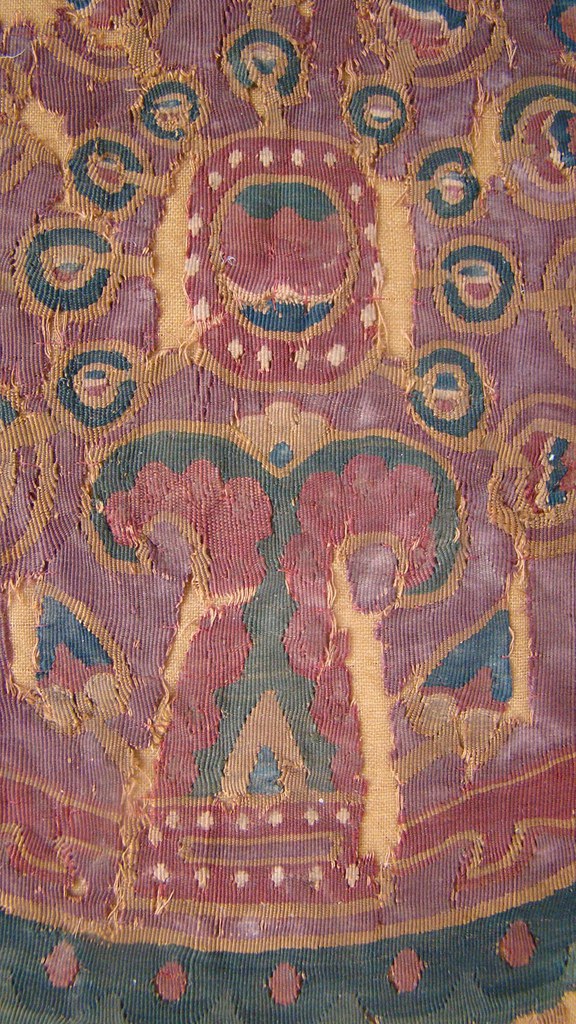
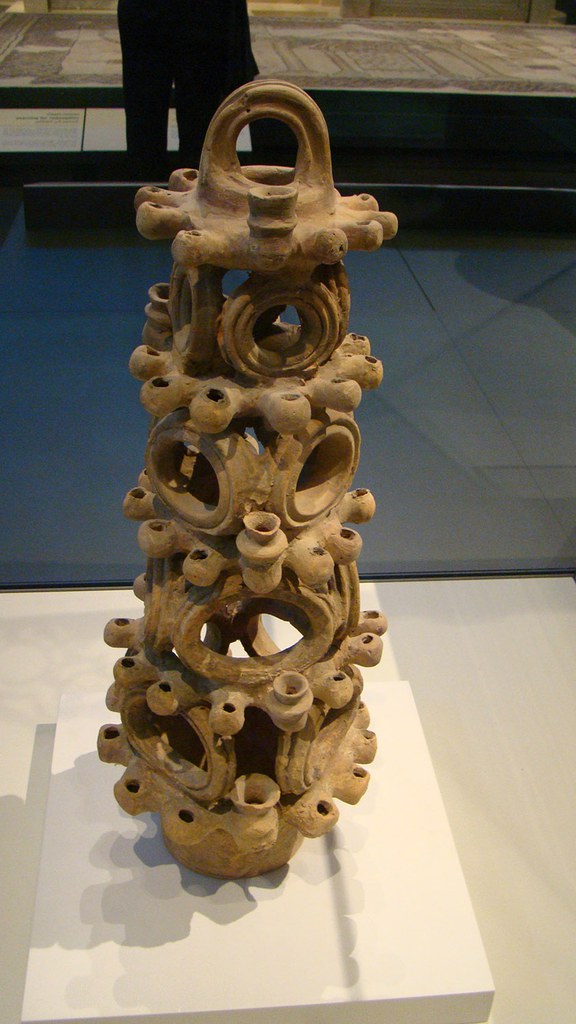
To some extent, this row of medallions on a red-purple background recalls the “Marwān” woven wool tapestry fragment at the Metropolitan Museum of Art and the “red family” discussed by Elizabeth Dospěl Williams.New York, The Metropolitan Museum of Art, Rogers Fund, 1950, 50.83, https://www.metmuseum.org/toah/works-of-art/50.83. This piece is strongly related, as Daniel Walker suggests, to two other inscribed fragments and therefore can be dated to the time of the Umayyad caliph Marwān II (744–749 CE); see D. Walker, “Tapestry Woven Fragment,” BMMA, n.s., 53, no. 3 (1995–96): 15. On the “red family,” see, in the present volume, E. Dospěl Williams, “A Taste for Textiles: Designing Umayyad and ʿAbbāsid Interiors.” And yet, when compared with the “red family,” and especially with the red piece in the Dumbarton Oaks Museum, the designs of the varied ornaments within the medallions of the textile from Split appear firmer and more compact, less natural or vegetal and more sculptural.Washington, DC, Dumbarton Oaks, BZ.1945.1, https://www.doaks.org/resources/textiles/catalogue/BZ.1945.1. The best example to illustrate the character of these motifs is the “peacock’s tail” ornament that occupies medallions B and D (figs. 3, 5). In addition to the elaborate base and pedestal supporting this ornamental structure, extra rings chain the “eye spots,” or disks, to each other, hinting at the more mechanical, rather than natural, character of this ornament. An early Islamic clay standing lamp at the Israel Museum in Jerusalem is reminiscent of this motif (fig. 9).It is tempting to suggest that this motif might also hint at the Seljuq metal polycandelon lamps, like that with three feet at the Linden Museum in Stuttgart (A 36.069 a L) or the one in the Walters Art Museum in Baltimore (54.2363). Though organized vertically, like a tower of lights, the large clay disks recall the circular motifs that form the widely spread tail of a peacock. Nevertheless, the tapestry piece at the Metropolitan Museum of Art, the Dumbarton Oaks fragment, and the textile from Split clearly suggest a decorative scheme that was nurtured by Sassanian designs and motifs.This Sassanian connection was also noted by Muthesius, “Two Unknown Tapestry Weave Silks,” 199n4. For a medallion textile similar in technique and color, see A. A. Ierusalimskaja and B. Borkopp, eds., Von China nach Byzanz: Frühmittelalterliche Seiden aus der Staatlichen Ermitage Sankt Petersburg (Munich, 1996), no. 71. It should be noted that a similar decoration appears on a tiny fragment, measuring 2 × 2.5 cm, of gold and silken knitted textile. The fragment was once used as a relic case and is today kept in the treasury of the Abbey of Saint Maurice in Switzerland. It displays the same dotted pattern that decorates one of the curved petals of the fantastic flowerlike jewelry on the Split textile. See B. Schmedding, Mittelalterliche Textilien in Kirchen und Klöstern der Schweiz (Bern, 1978), 179–80, no. 149.
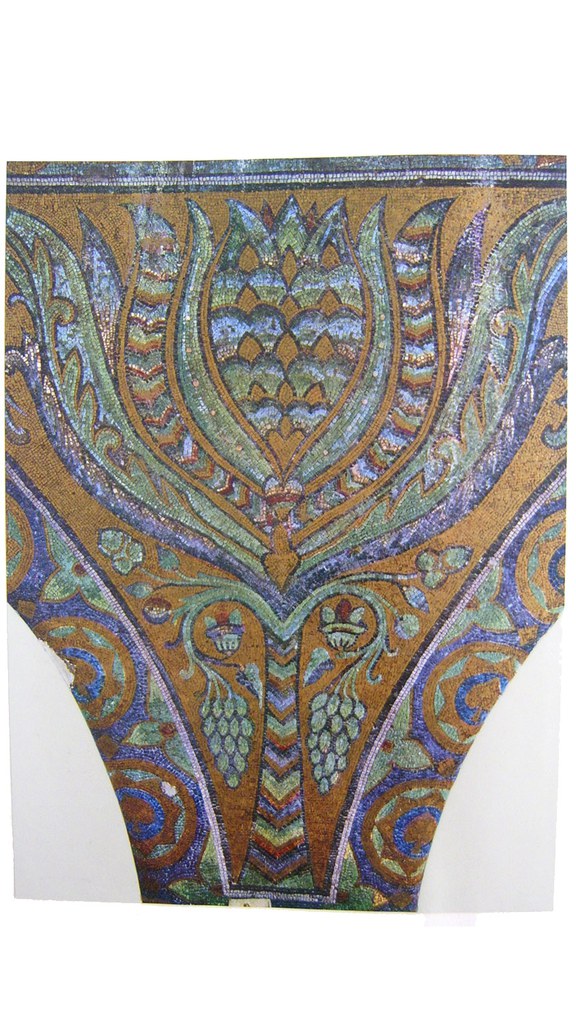
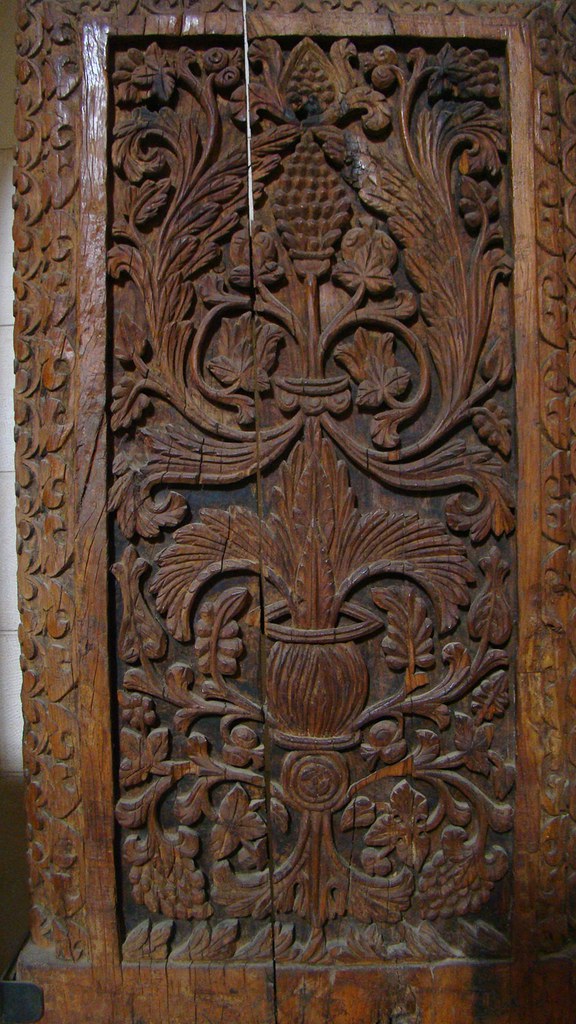
The royal and monumental character of this “sculptural” design becomes even more apparent when compared with early Islamic architectural decor. Several late seventh-century mosaics decorating the walls of the Dome of the Rock in Jerusalem are similar in their depiction of plants to achieve a monumental vegetal effect. For example, the fantastic palm tree that decorates one of the spandrels of the inner arcade of the Dome of the Rock presents an artichoke-like crest similar to that in medallion C (figs. 4, 10). The resemblance is apparent in the shape of the crest and in the differentiation in ornaments that appear on each of its segments. Moreover, the small branches with dates and fruits that appear at the lower part of the crest in the mosaic recall the specific pendant-like motifs depicted at the lower part of the plant-like object of medallion C. The same can be said about the crest at the uppermost part of the carved wooden beam from the al-Aqṣā Mosque (dated to the early eighth century), kept today at the Rockefeller Museum in East Jerusalem (fig. 11). The lotus-like flower has the same shape and is distinguished by the curled ends of the flower’s petals. The best example, perhaps, of the bisected, bell-shaped flower motif is found in the carved stucco medallions on the upper walls of the early Umayyad palace of Qaṣr al-Kharāna in Jordan (early eighth century, fig. 12).See mainly S. K. Urich, Qasr Kharana in the Transjordan (Durham, NC, 1987); see also R. Talgam, The Stylistic Origins of Umayyad Sculpture and Architectural Decoration (Wiesbaden, 2004). Similar to the textile from Split, the bisected plants from Qaṣr al-Kharāna appear in medallions and are organized in a row, thus forming a decorative band that runs horizontally along the upper part of the wall, just below the barrel-vaulted ceiling. The commonalities between these examples of architectural decoration and textile patterns prompt us to speculate on the potentially tautological effect that would have resulted when textiles resembling the Split tapestry were hung in early Umayyad palaces. The mixture of architecture and textiles, of hard and soft, would have enriched the visual experience of these palaces, as would the juxtaposition of two repetitive motifs made of two different substances. By underscoring difference amid resemblance, the transmedial artistic effect of such combinations would undoubtedly have heightened the visual engagement of beholders.These interactions between textile and architecture in the medieval Islamic world, as Robert Hillenbrand has noted, “are legion and constitute a fertile field for future research”; R. Hillenbrand, Islamic Architecture: Form, Function and Meaning (New York, 1994), 405.

Umayyad rulers seem to have favored the use of monumental medallion patterns with vegetal motifs, either carved in stone or stucco, in palatial visual culture. The façade of the late Umayyad palace of Mshatta in Jordan (first half of the eighth century), on which huge rosettes are framed by an overriding zigzag pattern, best illustrates this aesthetic notion.The literature on this palace and its façade is considerable. For an extensive description of the monument, see B. Schulz and J. Strzygowski, “Mschatta,” Jahrbuch der königlich preuszischen Kunstsammlungen 25 (1904): 205–373; K. A. C. Creswell, Early Muslim Architecture, 2nd ed. (Oxford, 1969), 1:350–75; V. Enderlein and M. Meinecke, “Graben – Forschen – Präsentieren: Probleme der Darstellung vergangener Kulturen am Beispiel der Mschatta-Fassade,” JbBM 34 (1992): 137–72. Recent studies include: S. Weber and E.-M. Troelenberg, “Mschatta im Museum: Zur Geschichte eines bedeutenden Monuments frühislamischer Kunst,” Jahrbuch Preussischer Kulturbesitz 46 (2010): 104–32; E.-M. Troelenberg, Mschatta in Berlin: Grundsteine islamischer Kunst (Dortmund, 2014). The huge horizontal and elongated band with medallions, appearing as if a textile has been stretched across the palace’s façade, transmits the idea of wealth and power (fig. 13). A similar use of monumental rosettes and medallions also appears in another Umayyad palace, Khirbat al-Mafjar (Hishām’s Palace) in Jericho, which was probably built between 739 and 744.On Khirbat al-Mafjar, see mainly O. Grabar, “The Umayyad Palace of Khirbat al-Mafjar,” Archaeology 8 (1955): 228–35; R. W. Hamilton, Khirbat al Mafjar: An Arabian Mansion in the Jordan Valley (Oxford, 1959); idem, Walid and His Friends: An Umayyad Tragedy (Oxford, 1988); and H. Taragan, Paṭronut ṿe-omanut be-armon ha-Umayi bi-Yeriḥo [Patronage and art in the Umayyad Palace in Jericho] (Jerusalem, 1997). See also R. Ettinghausen, “The Throne and Banquet Hall of Khirbat al-Mafjar,” in From Byzantium to Sasanian Iran and the Islamic World: Three Modes of Artistic Influence (Leiden, 1972); R. Hillenbrand, “La Dolce Vita in Early Islamic Syria: The Evidence of Later Umayyad Palaces,” AH 5, no. 1 (1982): 1–35. On visual experiences in Khirbat al-Mafjar, see also idem, “The Symbolism of the Rayed Nimbus in Early Islamic Art,” Cosmos 2 (1986): 1–52; D. Behrens-Abouseif, “The Lion-Gazelle Mosaic at Khirbat al-Mafjar,” Muqarnas 14 (1997): 11–18; and H. Taragan, “A Matter of Looking: The Female Images in the Umayyad Palace at Khirbat al-Mafjar,” in The Metamorphosis of Marginal Images: From Antiquity to Present Time, ed. N. Kenaan-Kedar and A. Ovadiah (Tel Aviv, 2001), 69–78. Hana Taragan also recently presented a paper on textiles at Khirbat al-Mafjar, “Beyond the Veiled Wall: Textile Obsession in the Umayyad Palace at Khirbat al-Mafjar (Jericho),” College Art Association conference, Washington, DC, February 4, 2016. Thus, the silken medallion textile from Split, along with the “red family” group of woven wool textiles of the early Islamic period, might illustrate a specific aesthetic penchant for monumentality and the use of rosettes and medallions as emblems of power at the Umayyad court.
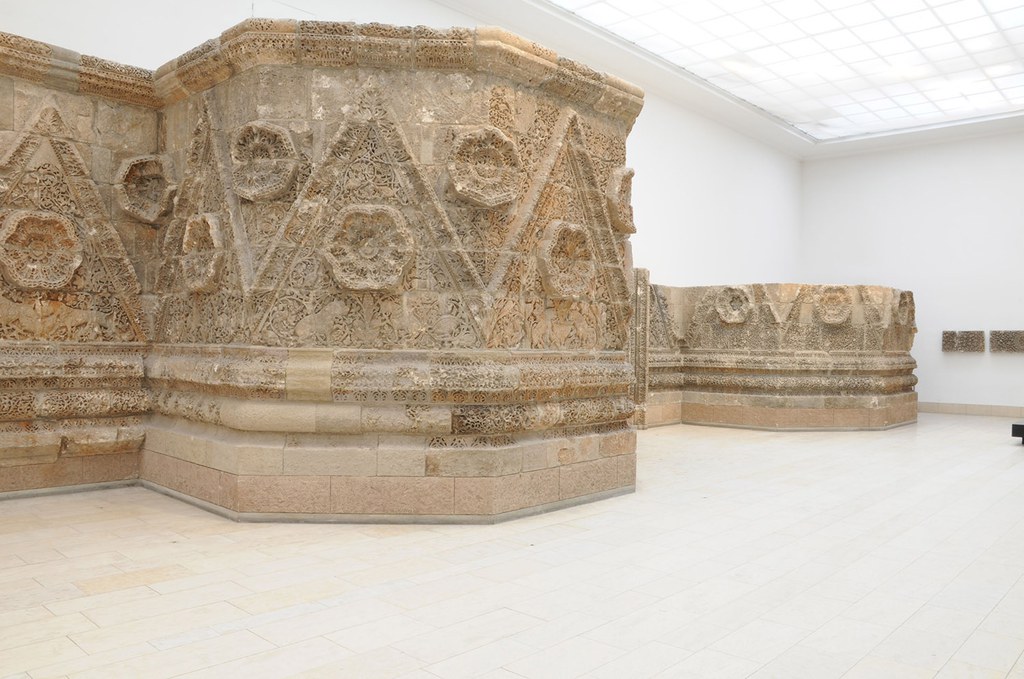
My Name Is Red
The meaning attached to the color red (ahmar) in medieval Arabic and Persian literature is too vast to cover in this short study. Recently, Maribel Fierro and Marianna Shreve Simpson have discussed the roles and meanings of this color in the Muslim world.M. Fierro, “Red and Yellow: Colors and the Quest for Political Legitimacy in the Islamic West,” in And Diverse Are Their Hues: Color in Islamic Art and Culture, ed. J. Bloom and S. Blair (New Haven, CT, 2011), 79–97, and M. S. Simpson, “Why My Name Is Red: An Introductory Inquiry,” in ibid., 273–303. Fierro clearly demonstrates how red came to be associated with prophetic qualities and, in turn, with the caliphate established in Córdoba by ʿAbd al-Raḥmān III in 929.Fierro, “Red and Yellow,” esp. 82–90. But the love and preference for red in the early Umayyad context of the seventh and eighth centuries might well be rooted in the imperial connotations that red and purple enjoyed in classical and late antiquity.For the meaning of purple in antiquity, see H. Blum, Purpur als Statussymbol in der griechischen Welt (Bonn, 1998); H. Stulz, Die Farbe Purpur im frühen Griechentum: Beobachtet in der Literatur und in der bildenden Kunst (Stuttgart, 1990). For the distinction between violet, sky blue-purple, and red-purple, see A. Dedekind, Ein Beitrag zur Purpurkunde (Berlin, 1906), esp. 40–42. See also the discussion of purple and red in M. Schoeser, Silk (New Haven, CT, 2007), 27.
In Exodus 35, the Israelites’ preparations for the making of the tabernacle and its sacred ritual objects attest to the great esteem in which purple and scarlet textiles were held. It is related that “everyone who possessed blue [thcheleth] or purple [argaman] or crimson yarn [tholaʿat ha-shani] or fine linen [shesh] or goats’ hair or tanned [meodamim, or ‘dyed red’] rams’ skins or fine leather, brought them” (Exod. 35:23). Moreover, “all the skillful women spun with their hands, and brought what they had spun in blue [thcheleth] and purple [argaman] and crimson yarns [tholaʿat ha-shani] and fine linen [shesh]” (Exod. 35:25). The biblical text goes on to describe how God filled Bezalel and Oholiab, the great craftsmen of the Jewish temple, “with skill to do every kind of work done by an artisan or by a designer or by an embroiderer in blue [thcheleth], purple [argaman], and crimson yarns [tholaʿat ha-shani], and in fine linen [shesh], or by a weaver—by any sort of artisan or skilled designer” (Exod. 35:35).
The richest medieval source for the merits of the color ahmar is the chapter on the ruby found in the book on mineralogy, Kitāb al-Jamāhir, by the famous mineralogist and geographer al-Bīrūnī (973–1048).Al-Bīrūnī, Precious Stones, 29–75. Besides the clear association between the color red and blood, to which I will return later, al-Bīrūnī first discusses its varied shades, all of which he compares to particular flowers and fruits: rummani (pomegranate-like), wardi (roselike), and ahmar ʿusfuri (red-saffron). A further term, urjuwan, which refers to a red- or wine-colored flower, is discussed extensively by al-Bīrūnī:
Ibn Durayd writes about urjuwan that it is the Arabic equivalent of the Persian word. The colour (of the flower) is deep red, and it is also called the qirmiz. In an exaggerated description of the colour of a piece of cloth, it is said that it is arghawani or bahramani. The Persians call it the gul-i-arghuwan from which the Arab word derives. This blossom effloresces from a plant which does not grow profusely, the flowers are minuscule, red and wine-coloured. They are odourless and appear very graceful. Whether it has an Arabic or Persian cognomen, the people of Arabia mention it quite frequently. Thus ʿAmr bin Kulthum says: “As if their clothes were dyed in urjuwan or urjuwan was coated upon them.”Ibid., 33.
Al-Bīrūnī moreover adds, “Urjuwanian colour is specific to the Caesars, and it was prohibited for the common people in ancient times to wear clothes of this colour, who were led to believe that it contained the blood of the snail.”Ibid. The restricted, royal use of clothes dyed urjuwani is also attested by al-Bīrūnī’s account of an incident at the court of the Sāmānids, who governed the regions of Khorasan and Transoxiana from 819 to 999. It is said that an individual named Ban Yanal Thanawi informed the Sāmānid kings about the costumes worn by the chief of the Qata’is (the Chinese). Thanawi reported that the royal garment of the chief was arghuwanian and that it was “so specific to him that none else was entitled to put it on.”Ibid.
The use of the term arjuwani/urjuwani (and variations thereof), which was usually associated with the ruby, for the red garments of kings is intriguing. It might be suggested that the ruby and its arjuwani color were considered imperial and majestic on account of the costliness of this gemstone. In fact, however, the term seems to relate to a specific purple-red color, namely royal purple. The encyclopedist and physician Ibn al-Akfānī (1286–1349) discusses the term urjuwani in his book on gemology as related to the color of the ruby (yaqut), describing it as purple-red.A. Sadouki, Die Farbenlehre der Araber (Hildesheim, 2015), 28. In his book on the creation of colors, the famous Persian scientist and intellectual Nāṣir al-Dīn al-Ṭūsī (1201–74) discusses the varied nuances of red (humra), starting with the brighter wardi (roselike) and then mentioning shafaqi (twilight red), damawi (blood-like), urjuwani (purple-red), and banafsaji (violet-red).Ibid., 123. As is the case in all medieval tractates on colors, colors in the Islamic world were distinguished by their specific level of brightness or darkness. See the excellent introductory discussion on colors by J. Bloom and S. Blair, “Color in Islamic Art and Culture,” in Diverse Are Their Hues, esp. 10–25.
It is likewise plausible that stories about the specific merits of urjuwani and its frequent association with rubies were known in the early days of Islam, in the Umayyad and the ʿAbbāsid courts. For example, al-Bīrūnī tells us that the Umayyads were greatly interested in mineralogy and especially in the prices of precious stones. He even mentions a specific book on the varieties of rubies and their cost that was written during the reign of ʿAbd al-Malik b. Marwān (685–705).Al-Bīrūnī, Precious Stones, 43. Al-Bīrūnī also emphasizes the overabundance of jewelry toward the end of the Umayyad period and in the early days of the ʿAbbāsids.Ibid., 46.
It is worth turning our attention therefore to the etymology of the term argvana (dark purple-red), which most likely refers to urjuwan. In the Book of Daniel, after Belshazzar witnessed a hand writing on the wall in his palace, he “cried aloud to bring in the enchanters, the Chaldeans, and the diviners; and the king said to the wise men of Babylon, ‘Whoever can read this writing and tell me its interpretation shall be clothed in purple [argvana], have a chain of gold around his neck, and rank third in the kingdom’” (Dan. 5:7). Belshazzar’s promise to present a red garment to the one who is able to give meaning to the indecipherable inscription belongs to the long tradition of bestowing robes of honor on the king’s devotees. The fact that the garment is mentioned as being argvana, the specific purple color reserved for royalty, ensured that the one who wore this garment would immediately be recognized as protected by the king. In another example, a fresco from the synagogue of Dura Europos (ca. mid-third century CE) illustrates the scene from the Book of Esther (6:6–11) in which Mordecai is presented to the citizens of the city of Shushan on a royal white horse and dressed in a red garment with which King Ahasuerus had honored him (fig. 14).
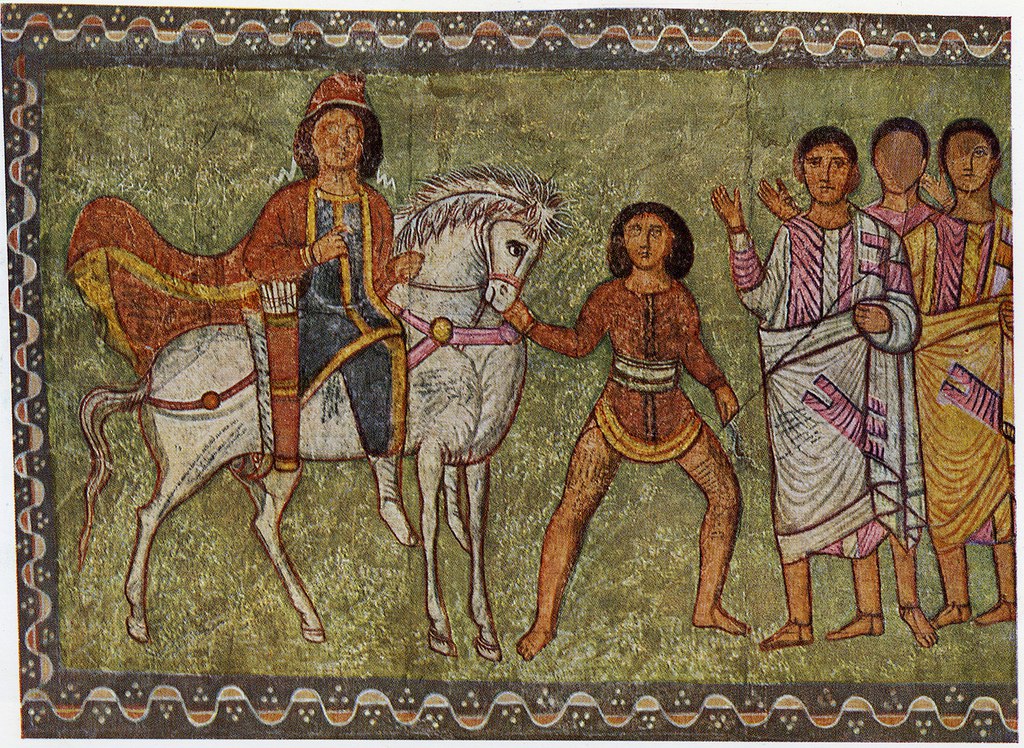
The biblical Hebrew term argvana, which derives from the Assyrian argamannu, is usually translated into English as purple but refers more specifically to this shade of purple-red.For this Assyrian term, see F. Delitzsch, Assyrian Grammar, trans. R. S. Kennedy (Berlin, 1889), 178. Another term, argaman, which usually refers to a dark, deep-red color, frequently appears next to the terms shesh and buz. In the Bible, the word shesh probably signifies a delicate Egyptian textile that was woven of fine linen and embroidered.See, for example, its use in Ezekiel 27:7: “Of fine embroidered linen from Egypt was your sail, serving as your ensign.” The term buz designates a fine linen textile manufactured in the land of Aram, probably the ancient Aramaean kingdom in Mesopotamia.See Ezekiel 27:16 (“Edom . . . exchanged for your wares turquoise, purple, embroidered work, fine linen, coral, and rubies”) and Esther 8:15, in which the term buz refers to tachrich buz, namely an overcoat made of linen: “Then Mordecai went out from the presence of the king, wearing royal robes of blue and white, with a great golden crown and a mantle of fine linen and purple.” The mention of argvana next to these two textiles of exceptional manufacture is quite interesting because it might indicate that the term argvana was used primarily to designate the royal red-purple textiles.See also G. Steigerwald, Purpurgewänder biblischer und kirchlicher Personen als Bedeutungsträger in der frühchristlichen Kunst (Bonn, 1999), 12–20 (on the meaning of the royal purple garment of Christ) and 196–205 (on the general meaning of purple clothing).
The Umayyads’ desire to associate their new Muslim empire with the legendary biblical kingdom of Solomon might also have contributed to their rulers’ preference for the color red.On the Solomonic aspirations of the Umayyads and their building project in Jerusalem, see mainly P. Soucek, “The Temple of Solomon in Islamic Legend and Art,” in The Temple of Solomon: Archaeological Fact and Medieval Tradition in Christian, Islamic and Jewish Art, ed. J. Gutmann (Missoula, 1973), 73–123; eadem, “The Temple after Solomon: The Role of Maryam Bint ʿImran and Her Mihrab,” Jewish Art 23/24 (1997–98): 34–41; eadem, “Solomon’s Throne/Solomon’s Bath: Model or Metaphor?” Ars Orientalis 23 (1993): 109–34. See also H. Busse, “The Temple of Jerusalem and Its Restitution by ʿAbd al-Malik b. Marwan,” Jewish Art 23 (1997): 23–33; R. Shani, “The Iconography of the Dome of the Rock,” Jerusalem Studies in Arabic and Islam 23 (1999): 158–207. As Michelina Di Cesare has discussed, the anecdote of Solomon’s red banner (ʿalam ahmar) was related by Wahb b. Munabbih in his Kitāb al-Tījān fī mulūk Ḥimyar and later retold by ʿUmāra b. Wathīma (d. 902) and Ibn ʿAsākir (1105–76): “(Ibn) Ishaq told us that he heard from Abu Ilyas that he heard from Wahb that the demons had made for Solomon a town [madīna] of glass. When he went on a military campaign he took that town with him and his servants and his family. . . . On each portico were all the dwellings he required, and domes and commodities. The highest dome was that of his throne hall [majlis], on which was a red banner [ʿalam ahmar] that during the night lit up the army and shone at night from the far-away land as a fire.”M. Di Cesare, Jamshīd’s Takht or Solomon’s Malʿab? Archaeological Reflections on Persepolis and Istakhr in Arabic and Persian Texts (9th–15th Centuries) (Rome, 2015), 36–37. The fact that the banner has a gleaming red color like fire probably ensured that it could be seen both day and night. Nevertheless, its radiance suggests that it was believed to have magical qualities. No less important are the several accounts taken from the ṣaḥīḥ (gathering of the sayings of the Prophet Muḥammad) of the Persian scholar al-Bukhārī (810–870).M. ibn Ismāʿīl al-Bukhārī, Ṣaḥīḥ al-Bukhārī, trans. M. M. Khan (Cairo, 1990), also available via https://sunnah.com/bukhari. These accounts imply that the color red, like green, was strongly linked to the Prophet. In one of the sections on clothes (libās), al-Bukhārī includes two anecdotes. The first is related by al-Barāʾ: “The Prophet was of a modest height. I saw him wearing a red suit, and I did not see anything better than him.”Ṣaḥīḥ al-Bukhārī 5848, bk. 77, no. 65, http://sunnah.com/bukhari/77/65. This anecdote is also mentioned in Stillman, Arab Dress, 12. It is important to note that another piece of clothing, the khamisa—a large square piece of black cloth, mainly black, with decorative bands on the hems that were usually green and yellow—is also recorded as a specific garment that the Prophet wore: Ṣaḥīḥ al-Bukhārī 5823, bk. 77, no. 40, http://sunnah.com/bukhari/77/40. The second, which mentions a red tent in which the Prophet welcomed his companions, is related by Abu Juhaifa: “I came to the Prophet while he was inside a red leather tent.”Ṣaḥīḥ al-Bukhārī 5859, bk. 77, no. 76, http://sunnah.com/bukhari/77/76. It is thus likely that the leather tent was colored with red pigment. The “tent of audience” of the Prophet was one of his royal emblems. The fact that it was colored red suggests that this color enjoyed a stately connotation in this early period. It is therefore no surprise that the Umayyads adopted the color red for their official clothes and used it to decorate their royal palaces. Ḥammād al-Rāwiya, summoned to an audience with the Umayyad caliph Hishām Ibn ʿAbd al-Malik in Damascus (724–743), describes the palatial audience hall: “I was admitted into his presence and found him in a spacious house paved with marble; and he was in a majlis [audience hall] also paved with marble. There between every slab of marble and its neighbour was a strip (qaḍīb) of gold; and so it was with the walls. Hishām was sitting on a red carpet (ṭinfisa ḥamrāʾ) and his clothes were of red silk perfumed with musk and ambergris. In front of him were two containers of gold filled with crushed musk, which he stirred with his hand to diffuse the scent.”See M. Milwright, “Fixtures and Fittings: The Role of Decoration in Abbasid Palace Design,” in A Medieval Islamic City Reconsidered: An Interdisciplinary Approach to Samarra, ed. C. F. Robinson (Oxford, 2001), 105, citing the translation in Hamilton, Walid and His Friends, 76.
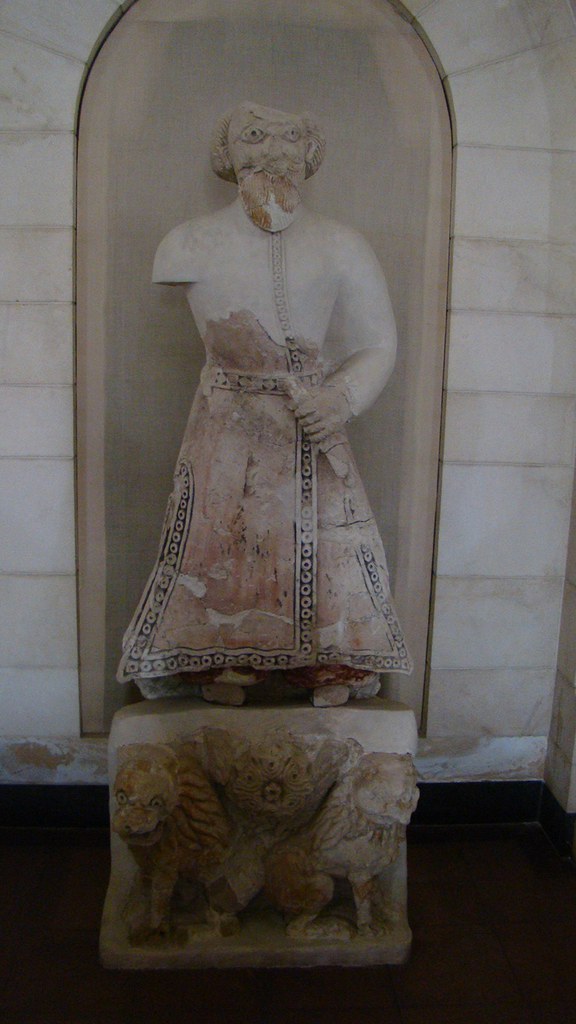
Remnants of red pigment appear on the statue of the standing caliph (fig. 15) in the unfinished Umayyad palace of Khirbat al-Mafjar in Jericho. This palace is datable to the reign of Hishām (724–743), but most likely was inhabited by his nephew al-Walīd from around 743/44 until 747/48, when the palace was abandoned following an earthquake. The caliph is depicted wearing an ankle-length, Sassanian-style garment (qabaʾ), decorated on its edges with pearl bands. An ornamental belt encircles his waist, and large trousers (sirwāl) appear below the hem of the bell-like skirt. The remnants of red pigment can be detected on the caliph’s clothing as well as on his beard and hair.Similar remains of red color appear on another statue in this palace, which probably represents another royal or important court figure, dressed in a belted robe with a fish-scale pattern. But it might be suggested that the entire sculptural program was mainly painted in brick red and saffron yellow.
In sum, despite the near nonexistence of surviving evidence of tapestry-woven silk textiles dated to the Umayyad period, and based on stylistic observations and some literary sources, it might be cautiously suggested that the silk tapestry from Split, with its dominant red and purple colors, was produced during the first half of the eighth century.I deliberately suggest an eighth-century date for this textile rather than assign it to a specific geo-cultural space of production. Moreover, I would like to emphasize that my use of the adjective “Umayyad” to describe this textile refers to a period of time rather than to a specific geographical space. Its medallion decoration seems to be inspired by early Umayyad architectural and monumental designs, such as mosaics, carved stone, and stucco reliefs, mainly those combining fantastic plants and flowers. The whole impression, though, evokes the memory of luxurious bejeweled artifacts and might therefore suggest a fashion that derived from late Sassanian art and the late antique trend of variatio, an aesthetic notion that demands detailed description and calls the beholder’s attention to the smallest units within patterns.M. Roberts, The Jeweled Style: Poetry and Poetics in Late Antiquity (Ithaca, NY, 1989), esp. 66–121. The tapestry, with its jewelry motifs and its stunning colors, calls to mind images of crowns and necklaces studded with precious stones. Its red-purple background, most likely urjuwani, evokes a host of connections to rubies and red-purple royal garments. It is tempting to suggest that the obvious association between the color red and blood might also suggest consanguinity, a metaphor for the blood relation of the Umayyads to the “family of kings.”O. Grabar, “The Painting of the Six Kings at Quṣayr ‘Amrah,” Ars Orientalis 1 (1954): 185–87. As mentioned above, the combination of similarly decorated textiles and architectural elements might appear as repetitive. But this ostensible tautology would have only enhanced the unity of the palatial decorative program while at the same time presenting a variety of materials and tactile surfaces to intrigue beholders, making them ponder, as we do, the aesthetic effects of this intermateriality, and marvel at the artists’ bravura in translating motifs from one medium to another.
Cite this Essay
Avinoam Shalem, “‘The Nation Has Put On Garments of Blood’: An Early Islamic Red Silken Tapestry in Split,” in Catalogue of the Textiles in the Dumbarton Oaks Byzantine Collection, ed. Gudrun Bühl and Elizabeth Dospěl Williams (Washington, DC, 2019), https://www.doaks.org/resources/textiles/essays/shalem.
